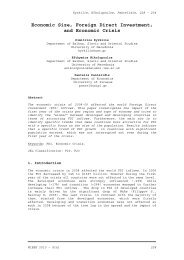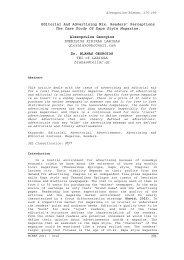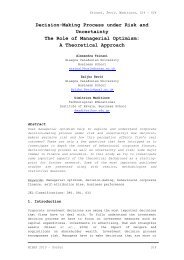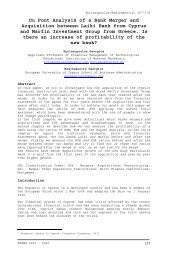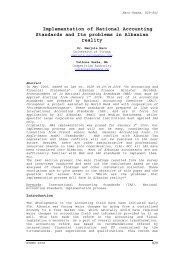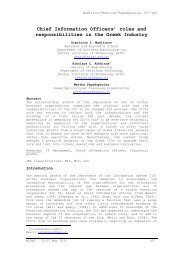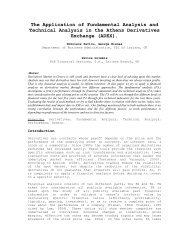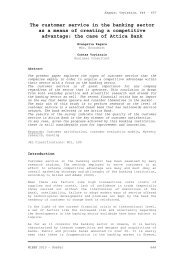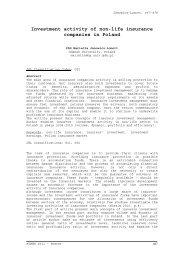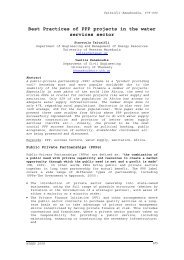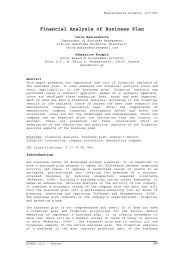Yilmaz B. S., Competitive Advantage Strategies for SMES in ... - mibes
Yilmaz B. S., Competitive Advantage Strategies for SMES in ... - mibes
Yilmaz B. S., Competitive Advantage Strategies for SMES in ... - mibes
Create successful ePaper yourself
Turn your PDF publications into a flip-book with our unique Google optimized e-Paper software.
Burcu Sel<strong>in</strong> <strong>Yilmaz</strong>, 106-117<br />
company must determ<strong>in</strong>e the mean<strong>in</strong>gful set of competitors <strong>in</strong> order to<br />
assess its advantages over rivals. Secondly, after determ<strong>in</strong><strong>in</strong>g<br />
relevant set of competitors, the second question is: Does the company<br />
have a susta<strong>in</strong>able edge over the competition? A three step process can<br />
be helpful <strong>in</strong> determ<strong>in</strong><strong>in</strong>g the company’s susta<strong>in</strong>able edge. This process<br />
is part of never-end<strong>in</strong>g cycle of creation and erosion of advantages<br />
that must be mastered to achieve superior profitability (Day and<br />
Reibste<strong>in</strong>, 1997, p.21):<br />
• The first step asks whether the company has demonstrated that it has<br />
an advantage by deliver<strong>in</strong>g superior customer value.<br />
• The second step is to understand the sources of these advantages.<br />
These are the superior assets and dist<strong>in</strong>ctive capabilities that set<br />
the organization apart from competitors.<br />
• The third asks how long these advantages can be susta<strong>in</strong>ed by putt<strong>in</strong>g<br />
impediments <strong>in</strong> the way of competitors’ ef<strong>for</strong>ts to imitate, and<br />
<strong>in</strong>vest<strong>in</strong>g to renovate the advantages or f<strong>in</strong>d new ones.<br />
Potentially effective strategies <strong>in</strong> competitive advantages of small<br />
bus<strong>in</strong>ess ventures can be summarized as follows (Meredith, 1988, pp.28-<br />
31):<br />
• serv<strong>in</strong>g personalized services to customers<br />
• flexibility and adaptability<br />
• specialized and customized products and services<br />
• effective and quick decision mak<strong>in</strong>g process<br />
• employer and employee motivation based on close relationships<br />
• geographic specialization<br />
Build<strong>in</strong>g a competitive advantage alone is not enough; the key to<br />
success is build<strong>in</strong>g a susta<strong>in</strong>able competitive advantage (Wickham,<br />
2006; Zimmerer and Scarborough, 2005). In the long run, a company<br />
ga<strong>in</strong>s a susta<strong>in</strong>able competitive advantage through its ability to<br />
develop a set of core competencies that enables it to serve its<br />
selected target customers better than its rivals. Core competencies<br />
are a unique set of capabilities that a company develops <strong>in</strong> key areas,<br />
such as superior quality, customer service, <strong>in</strong>novation, team build<strong>in</strong>g,<br />
flexibility, responsiveness, and others that allow it to leave beh<strong>in</strong>d<br />
its competitors (Zimmerer and Scarborough, 2005, p.69). When it comes<br />
to develop<strong>in</strong>g a strategy <strong>for</strong> establish<strong>in</strong>g a competitive advantage,<br />
small companies have a range of natural advantages over their larger<br />
competitors. Small bus<strong>in</strong>esses often have narrower product l<strong>in</strong>es, more<br />
clearly def<strong>in</strong>ed customer bases, and more specific geographic market<br />
areas than big bus<strong>in</strong>esses. Because of the simplicity of their<br />
organizational structures, small bus<strong>in</strong>ess owners are <strong>in</strong> touch with<br />
employees daily, often work<strong>in</strong>g side by side with them, allow<strong>in</strong>g them<br />
to communicate strategic moves firsthand. Consequently, small<br />
bus<strong>in</strong>esses f<strong>in</strong>d that strategic management comes more naturally to them<br />
than larger companies with their layers of bureaucracy and widerang<strong>in</strong>g<br />
operations (Zimmerer and Scarborough, 2005).<br />
A Research on Small Bus<strong>in</strong>esses <strong>in</strong> Tourism<br />
In order to determ<strong>in</strong>e the obstacles affect<strong>in</strong>g small bus<strong>in</strong>esses <strong>in</strong><br />
tourism sector and exam<strong>in</strong>e their competitive advantage strategies a<br />
research is conducted at lodg<strong>in</strong>g enterprises <strong>in</strong> Izmir, Turkey. Data<br />
are collected by <strong>in</strong>terviews with managers of selected lodg<strong>in</strong>g<br />
MIBES 2008 111



